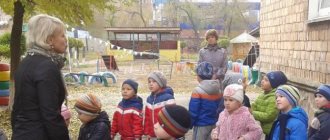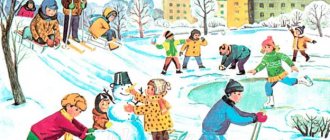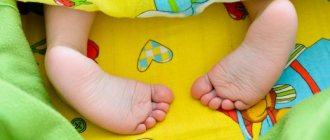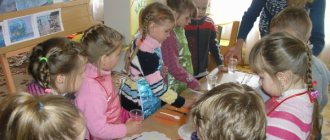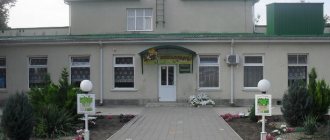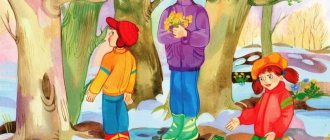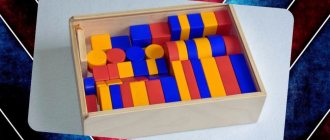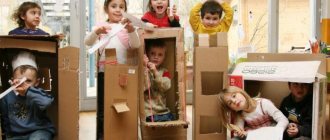Card file of autumn walks (senior group)
November.Card No. 5
1.Observation of rowan
Target:
consolidate knowledge about the benefits rowan brings to animals and birds in the cold season.
Progress of observation
So the first frost caught the rowan berries, they became tasty and soft. Animals and birds love rowan. A bear, if he finds it in the forest, hung with bunches of berries, will deftly tilt the flexible tree and enjoy its fruits with pleasure; The forest giants, elk, also like rowan berries. They reach the very top of the tree and eat fruits and branches with appetite. Berries that fall to the ground are picked up by voles, hedgehogs, chipmunks and squirrels. On pre-winter November days, flocks of bullfinches and waxwings arrive. They stick around the rowan and peck its juicy sweet berries. The birds peck quickly, dropping a lot of berries on the ground, then fly away further. Rowan saves many birds from hunger.
The crane's cry has already sounded, The garden has long since crumbled, And the bright clusters of rowan berries are still burning, hanging down.
2. “Sand cone” experiment.
Target:
show the property of sand - flowability.
Material: sand.
Procedure: Take a handful of dry sand and release it in a stream so that it falls in one place.
Gradually, a cone forms at the site of the fall, growing in height and occupying an increasingly larger area at the base. If you pour sand for a long time, first in one place, then in another, drifts occur; the movement of sand is similar to a current.
Conclusion: the property of sand is flowability.
3. Outdoor games
"Planes", "Sparrows and the Cat".
Target:
teach to quickly perform movements at the teacher’s signal and run in the indicated direction; cultivate friendliness.
4.Individual work
"Get in the basket."
Target:
develop accuracy and eye.
5. Didactic game
"Hide and Seek"
Target:
learn to find a tree by description, consolidate the ability to use prepositions in speech: behind, about, before, next to, because of, between, on; develop auditory attention.
6.Independent motor activity
November.
Card No. 5. Evening walk
1. Observation of migratory birds
Target:
expand ideas about migratory birds, about the changes in the life of birds in the fall, when cold weather sets in; foster love and care for birds.
The waters rustled like a fast stream, Birds flew away to warmer lands.
The teacher asks the children questions: What birds fly to warmer climes? Why are they doing that?
Birds gather in flocks and fly low above the ground. This means that they will soon fly away to warmer climes. Swallows will be the first to do this, since with the onset of cold weather the insects they catch in flight disappear. The last to fly away are ducks, geese, and cranes, as water bodies begin to freeze and they cannot find food in the water.
The teacher invites the children to complete the sentence:
• The sparrow is small, and the crane... (big).
• The duck is gray, and the swan... (white).
2. Didactic game “What kind of bird is this?”
Target:
clarify and expand ideas about bird life in autumn; describe birds by their characteristic features; cultivate a caring attitude towards birds.
Progress of the game:
Children are divided into 2 subgroups. Children of one subgroup describe the bird, and the other have to guess what kind of bird it is. You can use riddles. Then another subgroup asks their questions.
3. Word game “Do you remember these poems?”
Goal
: development of memory, attention, speech activity.
Progress of the game:
the teacher reads excerpts from poems familiar to the children. Children must pronounce the missing words.
Where did the sparrow have lunch? Don't stand too close:
At the zoo there are... (animals). I (tiger cub)
but not (…).
Wind across the sea (...)
And (...) customizes. Etc.
4. Outdoor game “Sparrows”. Target:
activation of the sound [h] in onomatopoeia;
development of dexterity. Progress of the game:
Children (sparrows) sit on a bench (in nests) and sleep. In response to the teacher’s words: “Sparrows live in a nest and everyone gets up early in the morning,” the children open their eyes and say loudly: “Tweet-chik-chik, chirp-chik-chik! They sing so joyfully."
After these words, the children scatter around the area. To the words of the teacher: “They flew to the nest!” - return to their places.
Labor activity:
Collecting pebbles on the site.
Target:
develop the ability to notice cleanliness in the area.
Notes on summer walks in the senior group
Read a poem about chamomile to the children.
A chamomile blossomed in the garden - A snow-white shirt, Petals once and twice. All carved lace. Nastya ran to the kindergarten and saw a daisy, and clapped her hands: “Oh, how good he is! We will transplant this little white flower into a pot.” Mom said affectionately: “But there’s not enough room in the pot. Let the chamomile grow in the garden - A snow-white shirt, Here is the sun and water, Let it bloom in the garden!” (L. Nekrasova) Invite children to find chamomile among other plants and describe its appearance: stem, leaves, petals. Examine chamomile with children: the color of the stem, leaves, petals, core, flower shape. Goal: To expand children's knowledge about chamomile and its beneficial properties. Questions for children: - How to find a chamomile among other flowers? — What shape and color are chamomile petals? — What is the healing value of chamomile? I conduct observation from the front. 2. Labor in nature. Water the plants in the flower garden. Loosen the ground. Remove weeds. Goal: To foster a caring and caring attitude towards plants.
3. Individual work with children. Teach girls to throw shuttlecocks to each other using a racket. Toss the shuttlecock above you using a racket. Goal: Develop movements in the game.
4. Games with children. Didactic games: “The fourth wheel”, “Make a group”. Goal: Develop children's speech, accumulate vocabulary. Role-playing game: “Shop” Purpose: To clarify children’s knowledge about store employees, about customers, about the importance of goods for everyday demand. Outdoor games: “Ball in”, “Tag with a ball”, “Tag with tails”. Goal: Develop movements in the game. Learn to act with the ball when given a signal.
Setting off on his flight, He hums like an airplane! Flying over the fields, over fragrant flowers, collects pollen from them and carries it to the porch. It quickly crawls into the hole and becomes quiet for a while. Who is this strange beast? This is our furry one.
I conduct observations in subgroups. After the observation, I conduct a conversation about the benefits of insects in nature.
2. Labor in nature. Invite children to collect garbage (sticks, branches, pieces of paper) in the area. Methods and techniques: demonstration, explanation, reminder, evaluation. Goal: To educate children to respect nature. Involve children in cleaning the kindergarten and caring for the environment.
3. Individual work with children: “Classics” Purpose: To train children in long jumps.
Continue to teach children how to navigate among numbers. Methods and techniques: demonstration, individual assistance, positive assessment.
4. Games with children. Didactic games" "Sound lotto", "Add a word". Goal: Accumulate children's vocabulary. Develop speech. Outdoor games: “Tag”, “Hide and Seek”, “Catch-Up”, “Day-Night”, “Homeless Hare”, “Mousetrap”. Goal: Improve children's running. Develop attention, speed, agility.
Read a poem about a butterfly to the children. I asked the yellow butterfly Quietly: “Butterfly, tell me, Who painted you?”
Maybe it's a buttercup? Maybe dandelion? Maybe yellow paint That Boy Next Door?
Or is it the sun after the winter boredom? Who painted you? Butterfly, tell me!
The butterfly, dressed in gold, whispered: “Summer, summer, summer has painted me all over!” Watch how beautifully, silently butterflies flutter over the flowers. Offer to examine the appearance of butterflies, body parts, and find out what they eat. Lead the children to the conclusion that butterflies differ in the size and color of their wings. Give the children a riddle: It flutters and dances over the flower, waves a patterned fan... Butterflies have 2 pairs of wings. They are covered with colored scales. The scales are very delicate and can be rubbed off with a light touch. Butterflies have 6 legs, with which they cling to flowers and move along them. They have antennae and a proboscis, curled into a spiral. Sitting on a flower, the butterfly unfolds its proboscis, lowers it inside the flower and drinks the nectar. Tell the children that butterflies fly from flower to flower, this is how they carry pollen. Pollinated plants will produce more seeds. Ask the children riddles about butterflies: All four petals of the flower were moving. I wanted to pick it, it fluttered up and flew away. Not a bird, but with wings: It flies over the flowers, collects nectar. Goal: To expand children's knowledge about the appearance of a butterfly and its meaning. Questions for children: - How many pairs of wings do butterflies have? —What are the wings of a butterfly covered with? — What does a butterfly do when it flies from flower to flower? I conduct observations in subgroups.
2. Labor in nature. Water the plants in the flower garden. - Guys, our plants have completely lowered their heads, they probably need to be watered, what do you think? Goal: To foster a caring and caring attitude towards plants.
3. Individual work with children: “Counting within 10” Goal: Continue to teach counting to 10 and back. Tell a poem about arithmetic: On Tanya’s sofa there are toys lying in a pile: Five nesting dolls, Pinocchio, and a cheerful Cipollino. Help Tanya count the toys.
4. Games with children. Didactic games: “Make a group”, “Geometric shapes”. Goal: To develop children's mathematical abilities. Role-playing game: “Zoo” Purpose: To introduce children to zoo workers. Give new information about the life of animals. Outdoor games: “Ball for a neighbor”, “Ball in”, “Tag”. Goal: Improve children's running, speed, agility. Psychological game “Magic Circle” Purpose: To teach children to compliment each other. Foster a sense of friendship and collectivism.
Read poems about crows to the children: High on the crown of a maple tree, a crow was preparing to sing, showed her singing talent, and shouted loudly “car-rrrr.” Watch the crows with your children, see how they fly. Feed the crows with your children and watch this process from afar. Offer to consider the crows: body parts, appearance, coloring. Consider a crow's feather with children. Give the children a riddle about crows: Two chatty neighbors were having a conversation on a branch. Very Important Persons These black...(crows). T. Lavrova. Goal: To expand children's knowledge about birds of the corvid family. Questions for children: - What do crows eat? —What do crows look like? -What kind of feather does the crow have? - How are crows useful? I conduct observations in subgroups.
2. Labor in nature. Invite children to collect garbage (sticks, branches, pieces of paper) in the area. Methods and techniques: demonstration, explanation, reminder, evaluation. Goal: To educate children to respect nature. Involve children in cleaning the kindergarten and caring for the environment.
3. Individual work with children: “Ball School”. Goal: Teach children in subgroups (4 people each) to throw a medium-sized ball over themselves and catch it with both hands. Continue to teach children (another subgroup of children - 4 people) to hit the ball on the ground with their left hand and reinforce hitting the ball on the ground with their right hand.
Observation of nature in summer in kindergarten for children 5-6 years old. Theme "In the land of flowers"
Tasks
- know and distinguish 6-7 flowering herbaceous plants;
- know the characteristic features of the appearance and structure of flowers, the frequency of flowering (primroses blooming in summer, autumn flowers), the dependence of growth and development on external conditions (moisture, nutritious soil, light, heat);
- recognize flowers in nature, in pictures, use the names of flowers in speech;
- distinguish flowers according to their place of growth (garden, meadow, field, forest, aquatic);
- have an idea of flowering medicinal plants (lungwort, lily of the valley, coltsfoot, dandelion, etc.);
- about how flowers are grown, how some of them reproduce;
- about the flower garden, its structure;
- know about the meaning of flowers in human life;
- be able to write a descriptive story about a flower.
Vocabulary work
Names : flowers, rose, tulip, chamomile, carnation, lily, bell (others, most often found in the area in the garden, parks and squares, meadows, forests, lakes and ponds), stem, roots, leaves, bud, petals, seeds, dried flowers, primroses, wreath, bouquet, medicine, perfume, jam, Red Book.
Signs: garden, field, meadow, aquatic, mountain, steppe, desert, rare, medicinal, spring, summer, autumn, annual, perennial, beautiful, fragrant, fragrant, tender as the sun, noble, proud, prickly, curly, creeping , bulbous, low, tall, colorful, alive, dry, healthy, stunted, bright, pale, wilted, fading, blossoming, laid down after rain, sun-loving, shade-tolerant, etc.
Actions: grow, bloom, close, open (petals), lower (heads), crumble, bend to the ground, turn to follow the sun, freeze, dry out, get sick, plant, sow, water, feed, heal, delight, delight, fly away ( seeds), collect, cut, tear, weave, make a bouquet, protect.
Observations of flowers at the preschool site, in parks and squares
The teacher tells a story about a flower and looks at it.
Questions
Progress of observation
While walking near the feeder, look at the bullfinch: pay attention to the fact that the bird’s body is covered with feathers: the feathers on the chest are red, the feathers on the back are gray, and the feathers on the head are black. The bullfinch has two wings and flies; there is a tail, beak, legs with claws.
2. Individual work on physical development
3. Labor activity
Clearing a path covered with snow.
Goal: to teach how to use a spatula correctly.
4. Outdoor games
1."From bump to bump"
Goal: to develop in children the ability to jump on two legs while moving forward.
2."Birds in Nests"
Goal: To teach children to walk and run in all directions without bumping into each other.
FEBRUARY
Walk 2
1. Observation
1. Observation “Footprints in the snow”
Goal: to continue training in identifying tracks in the snow: children's, adults, bird and animal tracks.
